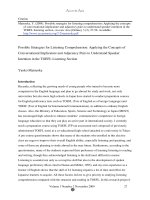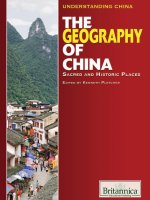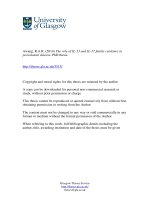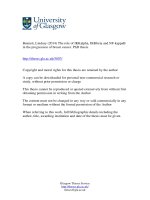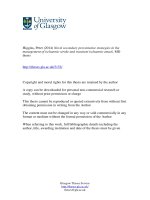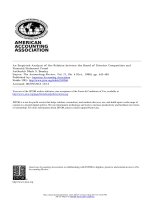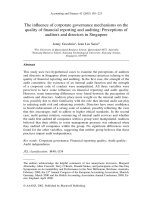The directions of moro integration and nationalism
Bạn đang xem bản rút gọn của tài liệu. Xem và tải ngay bản đầy đủ của tài liệu tại đây (3.05 MB, 127 trang )
DESIRING SIMILITUDE: THE DIRECTIONS OF
MORO INTEGRATION AND NATIONALISM
LOU JANSSEN DANGZALAN
(A.B. Sociology), University of Santo Tomas, Manila
(M.A. Global Politics), Ateneo de Manila University
A THESIS SUBMITTED
FOR THE DEGREE OF
MASTER OF SOCIAL SCIENCES
DEPARTMENT OF SOCIOLOGY
NATIONAL UNIVERSITY OF SINGAPORE
2010
Acknowledgements
It all started with a desire to escape the gravitational hold that Manila had over
me. Singapore provided an escape route at the end of my first graduate program in the
Ateneo.
To the Faculty of Arts and Social Sciences, and my home department,
Sociology, I am forever grateful for the chance to hone my skills and for giving me the
opportunity to have a brand new vista of the region. This research project took me
thousands of miles from home – though at this point, home has become a rather
problematic notion. Instead, I shall acknowledge multiplicities of places that I have
developed attachments to.
In Manila I thank my friends in the Ateneo and the University of the Philippines.
I am grateful to my friends, mentors, and professors: RR Rañeses, Aaron Moralina, RC
Cruz, BJ Enverga, Benjamin Tolosa, Jr., Matthew Santamaria, Filomeno Aguilar, Jr.,
Randy David, Walden Bello, and Francis Gealogo. They have been a constant source of
inspiration and disciplinary academic gaze throughout my candidature.
Daniel Goh, who was very patient with my innumerable quirks, gave me room to
grow. Removing the proverbial training wheels was the best “take away” that I have
from him; I am eternally grateful for his guidance and for those enlightening consultations
during my candidature in NUS.
I am very lucky to have a friend like Annette Ferrer who in my frequent transits
in Mani la gave me shelter from the elements of the domestics. My ever-intrepid former
colleagues and mentors in Newsbreak who at moments of academic ambiguity managed
to remind me to float down back to Earth. Special thanks go to the tres marias: Gigi Go,
Glenda Gloria, and Marites Vitug. Jesus Llanto, Aries Rufo, Carmela Fonbuena, Rey
Santos, Purple Romero, Cecille Santos, Lilita Balane, and Lala Rimando were very
accommodating when faced with my impertinence. For their patience, I thank them. In
the diasporic community of scholars engaged in their specializations, I am grateful to
Patricio Abinales, Julius Bautista, Reynaldo Ileto, Manuel Sapitula, Fiona Seiger, Maita
Sayo, Enrique Niño Leviste, Andy Soco, Michael Montesano, Douglas Kammen,
Rommel Curaming, Barbara Gaerlan, Jennifer Jarman, Jayeel Serrano, Dina Delias,
Cecille Lao, Justine Espina, and Diana Mendoza.
I thank my uncles and aunts across California: Ferdie & Arceli Meram in Los
Angeles, the Eskmans in Lake Tahoe, the Salazars in Antioch, and the Dangzalans in
Santa Cruz whose generosity made writing transnational history an even more fascinating
experience.
The Piang family network was indispensible in this research project. In New
York, Pete and Angel Meyer opened their home to me and took me in as if the years of
not seeing each other never existed. George and Rosette Trompeta from Chicago, who
have in their possession a thrilling collection of rare books and materials that pertain to
the Philippines during the colonial period, gladly shared them to me – to them I am
indebted. In Iloilo, the tales that my old grand aunt Grace Piang Trompeta shared were
instrumental in filling the gaps that the archives never managed to capture. I am grateful
to Deedee and Boy Dumayas in Iloilo for giving me an opportunity to see the Visayas for
the first time. Between Manila and Maguindanao, I will never forget the interesting
conversations I had with Didagen Piang Dilangalen who shared stories of his side of the
Piang family over cups of coffee before the sessions in Congress started.
In West
Hollywood, I thank my uncle, Nachie Meram, who so generously offered his house as my
own for 2 months. Also, my heartfelt thanks go to the Shevers and Jepsens of Iowa: Jane,
David, Jennifer, Michael, John, Johnnie, and Chebrai, whose transnational link to the
Philippines halfway across the globe through the Tropic of Cancer remains unwavering.
The bonds of friendship weaved in such a short span of time will be forever
treasured. I thank the people who were there for me in the past 2 years of my peripatetic
adventures: Kenneth Skinner, Thomas Barker, Kaye Dueñas, Melissa Sim, Seuty Sabur,
Weida Lim, Johan Suen, Kean Bon Lim, Sheela Cheong, Daniel Tham, Eugene Liow,
Sarbeswar Sahoo, Zdravko Trivic, Ng Hui Hsien, Denise Tan, Audrey Verma, Mamta
Sachan Kumar, Chand Somiah, Nurul Huda, Stefani Nugroho, Adlina Maulud, and Zat
Jamil in Singapore; Sayuj Panicker, Olaf Guerrero, Ana Chirinos, Arash Nikravesh, and
Benjamin Weinlich in Los Angeles; Ine Tiest in Brussels/Washington DC; Adam
Luckasiewicz, Damon Lazzara in Toronto; Casey Jepsen in South Dakota; Jasvinder
Singh Kandola in Oxford/Singapore/Manila; Kris Albert Lee in San Francisco/Singapore;
and William Panlilio in New York.
My mom, who in her curious attempts to perform global householding never
ceased to amuse me. I will never forget the moment when a mentor’s sociological
sensibilities were unsettled when he could not find his elements of what accounted for a
household when he was told that that my mom, my sister, and myself live in different
cities in different countries in the world but still managed to dutifully follow plans and
instructions. I am grateful to my mom, my sister, my grandma, and my grandpa. These
days when we are normally found in different places across the empire, we find our bonds
ironically stronger.
Finally, I dedicate this work to my late great-grandmother Visitacion Tangco y
Peralta viuda de Piang, and to my grandmother Erlinda Piang Meram. The topic for this
project would not have been conceived if it were not for their bedtime stories during the
power outages of the early 90s in Manila during my childhood.
Lou Janssen Dangzalan
Toronto, Canada
TABLE OF CONTENTS
Summary………………………………………………………………………...
i
List of Figures…………………………………………………………………...
ii
Chapter 1: Setting the Stage ……………………….………………………….
1
Introduction: Desiring Similitude and Other Anxieties
Literature Review: Ethnographic Possibilities
Problem and Thesis Statement
Methodological Considerations
1
6
11
17
Chapter 2: Collaboration and Subject Formation …………………………...
22
The Moros, the State, and Subject Formation
The Colonial Encounter and the Moro Repertoire
Variables in Collaboration and Subject Formation: Datu Piang’s Case
Intergenerational Shift and Pilgrimage
Tensions and Allegiances Amidst Structural Changes
The Moros Adapt
22
26
28
32
39
42
Chapter 3: The Bacon Bill ……………………………………………………..
44
Filipinization and the Desire for Similitude
A Republican Revenge and the Moro Repertoire
The Bacon Bill and Subject Formation
43
48
66
Chapter 4: The Commonwealth, the War, and the Republic ……………….
70
The Commonwealth and the Moro Repertoire
The Muslim Filipino Subject
New Trajectories and Integration
The War, and Moro Representations in Propaganda
Postwar Realities
70
72
74
81
85
Chapter 5: Conclusion …………………………………………………………
92
Contingent Subject Positions
Final Notes
92
94
References ………………………………………………………………………
95
Annex …………………………………………………………………………...
102
Piang Family Chart
101
SUMMARY
Local elites who collaborate with a colonizing power are implicated into the
colonial state matrix in different ways. In a field of multiple collaborating elites,
marginalized collaborators outwardly desire similitude towards other collaborators
through integration. But given an opportunity to disengage from a trajectory of
integration, these marginalized collaborators would readily do so. As to why
these leaders of the marginalized would choose to disengage from the hegemonic
narrative of the colonial state is the problematic of this investigation. Following
the history of Moros in the Philippines as context, and with the analysis of the
Piang family as a case study, I posit that the Moro subject was 1) created through
the process of colonial state building during the American regime and was
internalized by the Moros leading to the colonial encounter-produced subjects; 2)
that the Moro subject inflected ideas of difference that enabled them to disengage
at the moment of possible excision from the emerging body politic. I illustrate
this by using the year 1926 wherein Mindanao and Sulu were nearly separated
from the Philippines. I posit that the process of subject formation related to the
project of state building and the deployment of a cultural repertoire peculiar to
them was the reason why the Moro elites under consideration disengaged from the
hegemonic narrative of political independence.
i
LIST OF FIGURES
Figure 1.1
Datu Piang Greets Secretary of War, William Howard Taft
Figure 1.2
Datu Piang’s Sons
Figure 1.3
Map of the Philippines
ii
Dangzalan, Lou Janssen
Chapter 1: Setting the Stage
Introduction: Desiring Similitude, and Other Anxieties
“All datus must have realized by this time that, in spite of their people not
having gone to school, they have already been deprived of most of their old
powers and privileges as datus. In the very near future, these datus are bound to
have no more power unless they are educated or unless the people who will accept
them as datus are educated” – Gumbay Piang, 1934 (JRH 27/30/2).
These were the words of Gumbay Piang when he wrote an open letter
addressed to his fellow Moros. With a closer reading of this particular passage, it
is very hard to miss the anxiety, the feeling of exasperation, expressed by a Moro
datu1 who was worried about the potential loss of authority because of the
inflexibility or even the stubbornness of some leaders to the changing
circumstances. When Gumbay Piang wrote this letter in 1934, the tides have
already changed its flow. The winds have shifted in favor of Filipino nationalists
with the passage of the Tydings-McDuffie Act, which secured for Filipinos the
much-coveted status of political independence from the United States, a latecomer
in the game of imperialism.2 The Philippines Islands – its bureaucracy, it’s
political-economic structure (at the very least, on the surface) – were Filipinized,
much to the delight of Manuel Quezon3 and his compatriots in their nationalist
struggle that glorified the aborted republican aspirations.
Moros, and non-
Christian populations either stood at the aisle or partook in the serving of the
American dish of eventual independence.
1
A local leader, oftentimes taken for royalty in the context of the southern Philippines. In
island Southeast Asia, datus, or datos, are similarly positioned in their respective society.
The title is often inherited but can also be earned through the accumulation of wealth and
power.
2
The United States acquired the Philippine Islands under the 1898 Treaty of Paris
wherein Spain, the defeated party in the Spanish-American War, ceded the Philippines,
Guam, and Puerto Rico to the US in exchange for US$20 million dollars.
3
Prior to his career as the first president of the Commonwealth of the Philippines, he was
a vocal critic of the various Republican (US political party) administrators of the islands.
Quezon was the leader of the Nacionalista Party, which openly advocated for expedited
political independence for the Philippine Islands.
Page
1
Dangzalan, Lou Janssen
Chapter 1: Setting the Stage
In the context of the collaborative project of political independence for the
Philippine Islands, I raise an issue that is largely ignored, or relegated to
footnotes: desiring similitude.
The differences among the groups within the
Philippine Islands were never a big secret. Non-Christians, as they were called,
were institutionally marked by the state through various mechanisms to
exogenously disentangle whatever sameness that they have with the rest of the
inhabitants of the islands (see Kramer 2006). Shifting policies during the period
of American colonialism led to the integration of the Moros into the rest of the
Philippines’ population.
Accompanying the process, talk of assimilation,
integration, and of responsibility littered the mass media (BIA 350/5/573/5075-A1), while speeches of solidarity and sameness became de rigeur among politicians
who were based in Manila in the durée of American occupation (BIA
350/5/574/5075A-30).
The US, in its self-appointed mission of spreading civilization by taking on
the white man’s burden, embarked on a program of democratic tutelage (Taft, cf
Go 2008, p.1), which
basically
opened
up
positions of power in
the bureaucracy to ablebodied colonial subjects
as collaborators in the
Figure
1.1
(left)
Datu
Piang
greets
Secretary
of
War
William
Howard
Taft
(courtesy:
George
Piang
Trompeta)
formation
colonial
of
the
state.
Naturally, training institutions such as the public school system along with
practical political education (Go 2008) were opened up. Institutions of specialized
Page
2
Dangzalan, Lou Janssen
Chapter 1: Setting the Stage
training for government service such as the University of the Philippines, the
Normal School among others were instrumental in training a new cadre of
collaborators. Over time, leaders from the regions that have been marked by the
colonial state as different became more and more like facsimiles of their
counterparts from the Christianized
parts of the colonial state.
The training entailed a swift
transformation
for
some
of
the
provinces in the Philippines. Gowing
(1983) reports that the Moro province
registered one of the highest rates of
economic growth across the islands.
The transformation also brought about
the rolling out of the machinery of the
state,
which
included
schools,
hospitals and the like. Here are photos
that are of particular interest at this
Figure
1.2
Datu
Piang’s
sons,
Abdullah,
Gumbay,
and
Ugalingan
(courtesy:
George
Piang
Trompeta)
juncture. Figure 1.1 captures the moment when Datu Piang of Cotabato met the
highest-ranking civilian official of the US colonial government at that time,
William Howard Taft. The photo is taken from a postcard that was circulated
circa 1905. The fact that this kind of imagery was being circulated as a postcard
evokes a certain sense of expansiveness and imperial power that is possessed by
the US (see Balce 2006). It also makes clear to the consumer of the image that the
US can project its power widely (ibid). Figure 1.2 is a photo of Datu Piang’s sons
whom he sent to Manila to study under the colonial regime’s instrumentalities.
Page
3
Dangzalan, Lou Janssen
Chapter 1: Setting the Stage
Figure
1.3
Map
of
the
Philippines
with
marked
places
of
interest;
Moro
Province
highlighted
Page
4
Dangzalan, Lou Janssen
Chapter 1: Setting the Stage
After completing their studies in the schools set up in the province, these sons
were sent to Manila to further their training in different fields – law, agriculture,
and education – areas that were geared towards the expanding roles of the colonial
state. Another point of comparison that is of interest to us is the clothing articles
used by the Piangs. Between the father and the sons, there is an exhibition of
cultural and performative departure that the younger generation of Moro leaders
took. This kind of representation, a deployment of varied cultural repertoires,
illustrates to us at the material level what the Moros were performatively
expressing – an underspoken desire for similitude, especially when one compares
it to how Manila cliques carried themselves. In a similar vein, Francis B. Harrison
(1922), a former Governor-General at the time of the publication of his book,
remarked that one Datu Alamada was initially adamant in going to Manila in
order to visit Malacañang, the seat of governmental authority, in the year 1914
after his surrender because he feared that he had to conform to the standards of
Christian civilization. The latter was finally convinced when he received:
…Assurance that he could carry his kris at all times, and that he would not
be obliged to wear “Christian” clothing. Before the end of his first day in
Manila he had discarded his kris and surreptitiously procured an American
suit of clothes. Upon his return to Cotabato, he became insistent in his
demands for schools (Harrison 1922, p.108).
One would have to be blind and insensitive of elephantine proportions if one
failed to note the allure that Manila and its veneer of civilization had to offer to
these Moro datus. The Moro datus, impressed with what they saw as cultural
prowess was documented by Harrison to have wanted this prowess for themselves
by “procuring… American suit of clothes” along with demands for schools to be
built in his jurisdiction. Manila was like a flame as these Moro leaders were the
moths slowly sucked into the vortex of irresistible seduction.
Page
5
Dangzalan, Lou Janssen
Chapter 1: Setting the Stage
And at last we come full circle with the opening quotation from Gumbay
Piang’s letter to his fellow Moros. As I have mentioned earlier, the anxiety over
the loss of the political potency of indigenous power structures was clearly
intersecting with the desire for similitude by Moro leaders towards their colonial
counterparts in the Christianized regions of the Philippine Islands. While there
are men like Datu Alamada who would so readily discard the tubaw4 for an
“American suit of clothes,” we cannot deny the unevenness of this said desire.
This project aims to delve further into this desire for similitude and similarly will
be studying closely the intersection of the said desire with the dynamics of
collaboration and colonial state building.
Literature Review: Ethnographic Possibilities
Below is my attempt to narrate the historical background for the discussion
of my arguments in the latter chapters. Due to space constraints, I shall focus on
the ethnographic sketches that enabled governmental tentacles to stretch out
across the islands, and lastly, the trajectory and desires for the Moros as outlined
by the existing literature.
The census as a critical tool in the rolling out of the project of colonial
state building has been discussed by other comprehensive works.5 Works such as
4
A Mindanaoan head clothing.
5
See for example, Rafael (2000), who discusses the imperatives of the census,
discussing it as white love. For a discussion on the census as an exercise in
collaboration and racial politics, see Kramer (2006). For a more analytical discussion on
the importance of the census and of counting subject populations in the context of
nationalism and Southeast Asia, see Anderson’s (1998) Spectre of Comparisons.
Anderson (2008) also discusses the importance of the incidence of representations works
of fiction that are used in census categories in his work titled Why We Count.
Page
6
Dangzalan, Lou Janssen
Chapter 1: Setting the Stage
those establish the critical role that governmental instruments of “white love” play
in the project of state building.
While it seemed as if it was smooth sailing for the rolling out of the events
related to the said project, things started to look much more complicated when the
veritable internal Other(s) of the Philippine Islands were put under serious
scrutiny: the hill-tribes from the mountainous regions and the southern Muslim
groups that were barely touched by the limited reach of the former Spanish
sovereign presented a stumbling block that became a challenge for US colonial
officials. The ethnographic representations of the inhabitants of the islands were
subjects in a contentious debate – a series of disagreements on how to view the
inhabitants of the islands, which Goh (2007a; 2007b) has written on. The same
predicament befell American authorities when they were confronted with the
inhabitants of the island of Mindanao and the Sulu Archipelago. The Muslim
population of the said area was never fully subjugated by the Spanish authorities,
very much like their hill-tribe counterparts in the north. This contributed to the
imageries that pro-imperialist groups in the US were projecting, that the
Philippine Islands were indeed islands of different groups. This served the dual
purpose of displacing the image that nationalist mestizo elites were projecting in
order to gain ascendancy in a seriality, or series of nations.6
One of the things that I have as an operative assumption here is that the
ethnographic malleability of the Moros was largely influenced by particular
historical junctures.7 Lifting from Gowing (1983), I outline them as follows:
6
See Anderson (1998), who discusses the esoterics of his idea, the logic of seriality.
7
Also, these ethnographic representations have been heavily influenced by Spanish
colonial reports/accounts.
Page
7
Dangzalan, Lou Janssen
Chapter 1: Setting the Stage
First, by the US Army, which administered Moroland during much of the critical
period of its pacification and which saw the Moros as a martial race with their
views oddly punctuated by its relatively recent experiences with the pacification
of Native Americans in the westward expansion of the United States. Theodore
Roosevelt on the 4th of July 1902, possibly sitting comfortably on his chair in the
Oval Office halfway across the world, proudly declared that the “Philippine
Insurrection” has been dealt with (Kramer 2006; Golay 1997). For the hill tribes
in northern Luzon, power and authority were delegated by the Philippine
Commission to the Constabulary forces, while in the Muslim south the US Army
had a free hand (ibid). The consequences of dispensing American colonial
governmentality through the US Army in the Moro province are tremendous. For
one, direct army rule in the special province meant that the process of developing
a local pool of talent for local administrative operations took on a much slower
pace when compared to the rest of the colony (Amoroso 2005). The pastiche-like
caricature of Moros as savages who needed protection from potentially
exploitative Christian brothers from the north who are of the same “racial stock”
and are supposedly totally incapable of self-government served to reinforce the
said need to have an Army-led governmental structure in the south and also
justified the systematic exclusion of Moros from participating significantly in
governance (Gowing 1983; Thomas 1971; Davis c.f. Gowing 1983).
Second, by colonial official ethnographers with particular attention to the
person of Dean Worcester8 who played a critical role in the articulation of the
8
Dean Worcester was a University of Michigan trained zoologist who was appointed by
US President William McKinley as a member of the first Philippine Commission. He is
instrumental in the formation of key official ethnographic reports on the inhabitants of the
Page
8
Dangzalan, Lou Janssen
Chapter 1: Setting the Stage
Moro racial identity and/or ethnicity to the socio-political body of the rest of the
Philippine Islands – a strand that later on gained currency in the formation of the
colonial nation-state matrix. Key to the ethnographic representation of who or
what the Moros were was the Philippine Ethnological Survey.
A successor
agency of the Bureau of Non-Christian Tribes, the Survey was tasked mainly with
ascertaining the intricacies of the population of the islands. Dean Worcester, a
zoologist from the University of Michigan, was instrumental in the establishment
of the said Bureau, which was officially transformed from the Bureau of NonChristian Tribes into the survey in 1903 (BIA 350/5/3833-3). Thomas (1971)
sums up Worcester’s policy for the Moros as follows: study, separate government,
and paternalistic direction.
Goh (2007b) however discusses this further by
historicizing and teasing out the political nuances of Worcester’s views. Prior to
the Republican-Democratic turnover of 1913, Worcester viewed the Moros as a
savage race that needed to be repressed (ibid). When the Republicans were
booted out of power, Worcester perceived a betrayal of the American Manifest
Destiny by their Democratic successors and advocated, nay, pleaded for the
continued presence of Americans in the non-Christian areas to protect them from
possible exploitation by the Christian Filipinos who were earlier on calling for
independence, especially after the electoral debacle of the pro-American
Federalistas in 1907 (ibid; Cullinane 2003).
Third, Najeeb Saleeby,9 a Syrian-American doctor idealized the Moros
through the transcription of oral traditions into text, which in turn had a profound
Philippines as he sat as the Secretary of the Interior for the Philippine Insular Government
until 1913 after his tenure in the Philippine Commission.
9
Najeeb Saleeby came to the Philippines on board the SS Thomas, a steamship that
ferried American educators across the Pacific into the Philippines. Known as the
Page
9
Dangzalan, Lou Janssen
Chapter 1: Setting the Stage
impact on how Moros eventually came to view themselves in the future political
interaction with the national/mestizo elites and the colonial officials from the US.
He took on a different tack when it came to representing the Moros. Dr. Saleeby
used his knowledge of Arabic to study Moro culture and learned two Moro
languages in the process (Thomas 1971). His views about the Moros were largely
informed by his dalliances with prominent Moro families from the Sulu
archipelago to Mindanao (Gowing 1983). He traced their ancestries, translating
them into English rendering them visible to the colonial power, the American
colonial officials, and consequentially to an emerging Anglophone Filipino
audience as well. Again, Thomas (1971) succinctly summarizes Saleeby’s views
about the Moros: respectful understanding [read: religious tolerance], datu
responsibility [read: traditional authority], and structural integrity [read: political
stability]. The first necessitated a more dialogical understanding of the Moros,
giving them a chance to represent themselves to their colonial overlords. While
he made references to Spanish texts in terms of how the Moros were to be viewed,
or even having made references to British colonial management in the Malay
states, Saleeby’s stood out as a representation that was more germane to the
cultural and religious considerations of the Moros. The bottom line is that his
more patronizing and apologetic view of Moro hierarchy and authority translated
into his representation of the Moros as a martial race, similar to the US Army’s
narrative, but called for their leaders’ participation in government as a means to
limit their powers (ibid).
Saleeby noted the binding potential of occupying
Thomasites, the passengers are largely credited for the massive expansion and success
of the American-established public education system. Saleeby was stationed in the
southern Philippines where he was acquainted with Moro culture and subsequently
published books on the customs, laws, and practices of the aforementioned. He became
an authority on Moro culture and political practices.
Page
10
Dangzalan, Lou Janssen
Chapter 1: Setting the Stage
positions of power in government and suggested that their leaders be given limited
roles where powerful leaders should be placed in executive positions, effectively
placing them under direct supervision, while giving lesser leaders concessions in
perfunctory legislative posts.
Problem and Thesis Statement
Mentioned in the introduction was the ability of the colonial state to mark
ethnicities and differences. In the critical years of the American occupation of the
Philippines, colonial categories were made visible by instruments of state
building, such as census-taking, poll taxation, among others; these were largely
instituted from the top (Rafael 2000; Kramer 2006; Abinales 2000; Gowing 1983).
However, this should in no way necessarily mean that the creation of the said
categories was the exclusive prerogative of the colonial state. Certainly, a large
part of the process involved the responses that these moves elicited from below.10
Of large import here is one of George Steinmetz’ (2007) four determening
structures of colonial native policy.
He talks about the incorporation of
precolonial ethnographic discourse or representation (ibid).11 Another critical
component of colonialism that led to the success of it is collaboration.
Collaboration is an element of colonialism that one must take into account for
without the cooperation and collaborative endeavors of indigenous elites, imperial
10
Rafael (2000) and Kramer (2006) discuss the role of Filipinos in the deployment of
personnel across the island to conduct the first ‘scientific’ census in the Philippines.
11
The other three are as follows: 1) the competition for recognition of superior
ethnographic acuity by colonial officials; 2) the colonizers’ cross-identification with
culturally and physically constructed image of the colonized; and 3) responses by the
colonized (Steinmetz 2007).
Page
11
Dangzalan, Lou Janssen
Chapter 1: Setting the Stage
adventures would not have had so much success in the course of history
(Robinson 1972; Steinmetz 2007). One manifestation of the collaborative work of
local elites is how they responded to the push and pull of the colonial state’s
movement from its center. An empirical and theoretical puzzle is laid bare before
our eyes at this point – what then were these responses, and why these kinds of
responses; how do they fit together, and what picture does it offer? Initially, I
proposed that there were actions or non-actions taken by Moro elites in response
to the colonial state’s act of marking them as different from the rest of the islands’
inhabitants: a desire for similitude – along with the heaves and throes of Filipino
nationalism – coupled with the US’ flippancy with regard to the political status of
its “unincorporated” and “insular” possessions.
Before I discuss further the reaction of marginalized elites to the potential
disengagement from the hegemonic narrative of colonial state-building trajectories
I wish to address two things: first, that the elites received a different kind of
political education. The Moros were placed under a different regime because of
the bifurcation of colonial state policies as it was shaped or at least influenced by
how the ethnographic survey envisioned the colonial subjects. While the Moros
were marked as civilizationally deficient in comparison to their counterparts in the
Christianized regions of the Philippines, they were also idealized at the same time.
In fact, there were various potential trajectories that were discursively set by
colonizing forces in collaboration with the Moros themselves. The Moros were
marginalized in terms of their position with the rest of the Christianized
population of the Philippine Islands, especially when placed within the continuum
of civilization that the American colonial state inscribed upon the matrix of the
Page
12
Dangzalan, Lou Janssen
Chapter 1: Setting the Stage
geo-body of the Philippine Islands.12 Second, as the Moros were placed under a
different regime and were separated administratively, they were at the onset of
colonial state building insulated from the development of the electoral politics. It
was 1907 when the Philippine Assembly was established with representatives
from all parts of the colonial state convened. All members in the assembly were
elected by landed, educated and male Filipinos, except for the US appointed
representatives from the separately administered jurisdictions of the Mountain and
Moro Provinces (Golay 1997; Gowing 1983; Abinales 2000a).
While this
privileged certain families and individuals in the Moro Province by having made
gains with regard to the collaborative matrix with the Americans, this also
deprived them of an opportunity to parlay with their collaborative counterparts
from the other parts of the colony who exercised in suffrage on more equitable
terms. As the development of the colonial state shifted and gathered around the
pole of the Filipino nationalist cause, the Moro elites were left in a marginalized
position. This research explores the intersection of the desire for similitude and
the dynamics of collaboration and colonial state building. This is the contention
that this thesis puts forward: marginalized collaborating local elites outwardly
exhibit a desire for similitude with the rest of their fellow colonial elites when
placed towards a trajectory of eventual political independence. But when
presented with an opportunity to disengage from the hegemonic narrative of
colonial state-building trajectories, they become potential counter-elites who
compete for the colonial master’s gaze.
12
I deploy Thongchai’s (1994) concept at this juncture, while emphasizing the artificiality
of the union of Las Islas Filipinas and Morolandia.
Page
13
Dangzalan, Lou Janssen
Chapter 1: Setting the Stage
This is where the turning point of 1926 becomes very relevant to the
proposition that I’ve put forward, with the year being the time when the said
opportunity to disengage was presented when a congressman from New York
filed and lobbied for the passage of a bill that sought to separate the purported
Moro homeland from the rest of the Philippines. The year 1926 is a turning point
that allowed for the expression of sentiments that were swept under the rug, which
would have otherwise been left unsettled had it not for such an opportunity.
When opportunities for marginalized elites come about, and given a particular set
of circumstances, I’ve posited that they would be more inclined to disengage from
the hegemonic narrative of colonial state-building trajectories – in the particular
case that I talk of, that of the Philippines’ path towards political independence as
guaranteed in the Jones Law of 1916.13 The question now is why would these
elites choose to disengage from the said narrative? Why not side with the rest of
the Filipino leaders who have petitioned that the said bill be junked and that ideas
pertaining to the separation of Mindanao, Sulu, and Palawan not be entertained?
There are multiple ways of possibly answering this question. Coming
from several traditions and theoretical positions, the question may be addressed,
though we may come up with different answers. One of the possible ways of
which is by taking a rational choice approach on the matter. The fundamental
assumption of this theoretical purview is that actors are rational, utility
maximizers, and that they choose according to what’s best for their own interests
(Kiser & Schneider 1994; Turner 2006). Following this assumption, we can say
that Moro elites have basically chosen to disengage because they have deemed it
13
The Jones Law of 1916 outlined the rapid turnover of command in the bureaucracy
from American to Filipino hands. More on this in the next chapter.
Page
14
Dangzalan, Lou Janssen
Chapter 1: Setting the Stage
to be in their best interests. There are many studies that have employed ratchoice, which are accompanied by critiques against them. Julia Adams (1999),
for example, criticizes the works of Kiser & Barzel (1991) and Levi (1988) in
their use of the rational choice approach in the study of the state. She uses Europe
as an archive for her critical reading of the choice of theoretical lenses of analysis
(ibid).
Adams (1999) points out the weaknesses of the assumptions of rational
choice theory – that in using rat-choice as a theoretical tradition for analyzing
state formation, one would have to privilege the rulers, or the ruling class in the
ascertaining the trajectories of the project. In other words, theirs is a court-centric
approach. While it’s true that I’m using the biographies of individuals and of a
particular family and that they may be deemed as collaborating elites as a case
study, one would need to take cognizance of the fact that the parameters of the
field involves structural conditions that would be difficult to trace with rational
choice analysis. And even if one takes the assumption that these actors were
rational (read: utility maximizers) at the end of the day the issue at hand, which is
the explanation of why the Moro elites have chosen to disengage from the
hegemonic political trajectories of the colonial state, cannot be reached
sufficiently. In fact, the answer would be completely tautological if rational
choice theory is used: that the actors involved were rational and utility
maximizers, full stop.
Another way of approaching this is by taking a nativist position. Marshall
Sahlins (1995) in his discussion of how natives perceive outsiders for example
demonstrates to us the power that culture has in shaping our actions and
perceptions. The idea that there is a mine or an historical archive for an individual
from where her/his actions come from is not totally unsound. In fact, this was one
Page
15
Dangzalan, Lou Janssen
Chapter 1: Setting the Stage
of the main contentions that he made in his work – he was reacting against the
notion of a rational and utility maximizing man (ibid). Following this logic, we
may say then that the Moros were responding according to their innate traditions;
that they are mining the archive of their cultural experiences and traditions.
Herein lies the problem: the idea that a set of culture and tradition is readily
available for the collaborating Moro elites to refer to when they responded to the
push and shove of colonial state building is quite problematic. Abinales (2000a)
for one criticizes an identity based approach in understanding Moro responses. In
that particular case he was seeking for an explanation to the Moro rebellion of the
relatively recent past (ibid).
He said that previous scholarship emphasizing
identity in their analyses failed to see the structural issues (ibid; see for example
Gomez 2000; Brown 1988; Buendia 2002; Buendia 2001; Tan 1997; Gowing
1979; George 1980; Ahmad 1982; Mercado 1984). Also, interpreting cultural
systems in this manner brings up the Geertzian dilemma of having a framework,
while able to explain the internal dynamics of a community through a “shared
meaning system,” that fails in the task of explaining interactions with
externalities, or foreign intrusions (Go 2008). More importantly, if we use a
nativist position in the analysis of the actions of collaborating Moro elites, the
problem of assuming a relatively stable Moro identity and subjectivity existed
because of some historical convergence of interests (i.e. the Moro Wars) negates
the argument that the Moro identity and subjectivity is a relatively recent
formation, which this thesis is using as a central assumption in its understanding
of the formation of a Moro subject..
I humbly submit a third position – and some may describe it as a middle
way – as to why Moros would then disengage from the hegemonic narrative if
Page
16
Dangzalan, Lou Janssen
Chapter 1: Setting the Stage
given a chance: I posit that the Moros were responding as newly formed colonial
subjects. The Moro subject position was 1) imagined and made real by the
American colonial state and was internalized by the Moros themselves leading to
the colonial encounter-produced subjects; 2) these subjects inflected ideas of
difference that enabled them to disengage at the moment of possible separation
from the emerging political body.14 First, the Moro as an identity is a subject
category whose creation was facilitated by the mechanisms of colonial state
building. The ethnographic survey, for one, and the accompanying representation
of how the Moros were perceived by the Americans (US Army, Worcester,
Saleeby, et al) became a repertoire that the Moros readily deployed. The same
mechanism, that of colonial state building, articulated previous representations of
what the Moros were perceived to be in the Spanish accounts. The colonial
encounter, not only reified these older representations, but also rallied around a
central pole what the Americans believed to be an unproblematic Moro identity.
The responses taken by Moros to gather around the said pole does not preclude
agency on their part. The fact that they were able to strategically fit themselves
into the newly made subject category affirms their agential capacities.
The
succeeding chapters will thus explore the creation of the said subject and its
implications.
Methodological Considerations
14
There is a degree of self-essentialism here among the Moro elites. While there are
esoteric issues pertaining to essentialism per se that are quite problematic, this is not the
focus of the thesis. What the thesis zeroes-in on is the fact that there was strategic selfessentialism and that the this thesis will not delve further into the chief problematic of the
debate on essentialism.
Page
17
Dangzalan, Lou Janssen
Chapter 1: Setting the Stage
This project that I embark on utilizes a large amount of archival data.
Majority of the materials that has been put under consideration and under careful
scrutiny are largely texts that have been transcribed, written, catalogued, and
stored in archives located in different places on both sides of the Pacific, across
the Tropic of Cancer. Other than archival materials, I conducted one incidental
interview in order to reference and triangulate the historical/biographical character
of the case study under scrutiny.
Materials from the American Historical Collection at the Ateneo de Manila
University’s Rizal Library were most instructive in giving me signposts as to
where to go with respect to my topic. I was quite amazed with the amount of
primary materials that I found in both the National University of Singapore
Libraries and the Institute of Southeast Asian Studies. In the US, the newspaper
archives in the Los Angeles County Library were of much value. Utilized in the
archival work were the Bureau of Insular Affairs files stored in the US National
Archives 2 in College Park, Maryland. I also made use of the Joseph Ralston
Hayden Papers in the University of Michigan libraries in Ann Arbor, Michigan.
Methodologically, I take the tools of an historical-comparative sociologist
using largely historical institutionalism as a means to grapple with the process of
colonial state building. Historical institutionalism usually entails a lot of case
studies, and this project is no exception to the trend.
I study the process of colonial state building and how it intersects with the
biography of a family. In particular, I focused on the Piang family, mainly
looking at the patriarch, Datu Piang, and his sons, with particular attention to the
youngest among his male heirs-apparent, Gumbay Piang. I focused on Gumbay
Page
18

